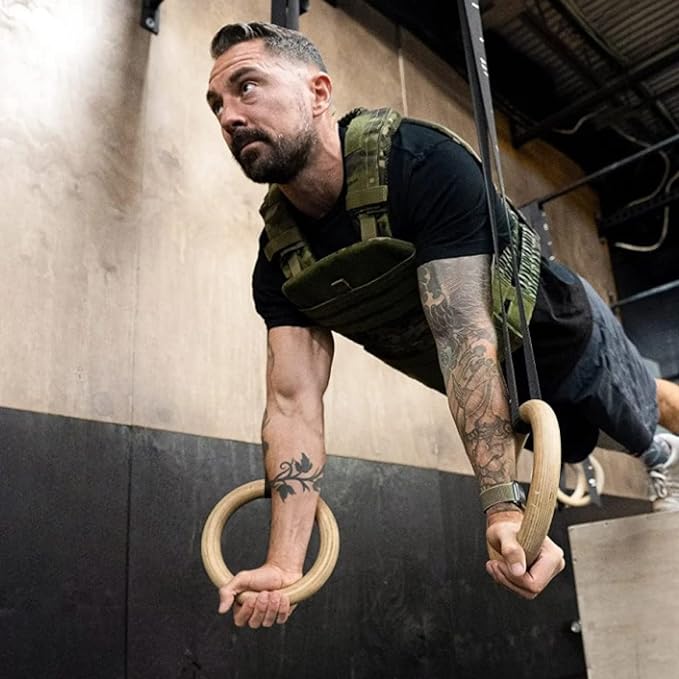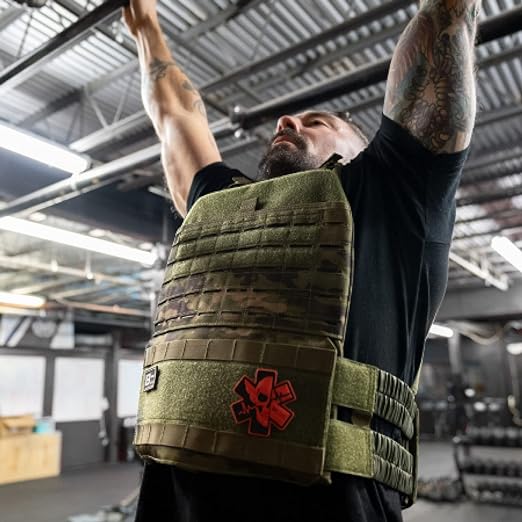Walking stands as a cornerstone of physical activity, often overlooked in its potential to enhance fitness and well-being. However, when coupled with weighted vests, this seemingly simple exercise undergoes a transformation, emerging as a powerful means to boost strength, endurance, and cardiovascular health. In this comprehensive guide, we'll delve into the multifaceted benefits of walking with weighted vests, unravelling the mechanisms behind its efficacy in fostering optimal physical conditioning.
What do Weighted vests do?Let's Understand
Understanding weighted vests involves recognizing them as versatile fitness tools designed to add resistance to various exercises and activities. These vests typically consist of adjustable pockets or compartments that allow for the insertion of weighted plates or sandbags, thereby increasing the wearer's overall body weight. By distributing additional mass evenly across the torso, weighted vests intensify the workload on muscles, enhancing strength, endurance, and cardiovascular fitness during workouts. The adjustable nature of weighted vests enables users to incrementally increase the resistance as they progress in their fitness journey, making them suitable for individuals of all fitness levels. Moreover, weighted vests come in various designs, ranging from light vests suitable for walking or calisthenics to heavy-duty vests tailored for strength training or high-intensity workouts. Understanding how to properly select, adjust, and incorporate weighted vests into fitness routines can unlock their full potential, helping individuals achieve their fitness goals effectively and safely.
Understanding the Science behind walking with Weighted vests
Understanding the mechanisms behind walking with weighted vests delves into the intricate physiological and biomechanical processes that underpin its effectiveness. Firstly, the added resistance from the weighted vests challenges the muscles throughout the body, triggering adaptations that lead to increased strength and endurance. This resistance not only engages the major muscle groups involved in walking, such as the quadriceps, hamstrings, and glutes but also recruits stabilising muscles, enhancing overall muscular development and coordination.
Walking with weighted vests stimulates bone remodelling and bone density improvement, particularly in weight-bearing bones like the hips, spine, and legs. As the body adapts to the increased load, it reinforces bone structure, reducing the risk of osteoporosis and fractures, especially in individuals susceptible to bone-related conditions. This aspect of weighted vest walking is particularly crucial for promoting long-term bone health, especially as individuals age.
The cardiovascular system experiences significant benefits from walking with weighted vests. The elevated heart rate and oxygen consumption during weighted vest walking lead to improvements in cardiovascular fitness and endurance. The heart becomes more efficient at pumping blood, and the lungs enhance their capacity to deliver oxygen to working muscles, resulting in enhanced overall aerobic capacity and reduced risk of cardiovascular diseases.
Additionally, the mental aspects of walking with weighted vests should not be overlooked. The cognitive engagement required to maintain balance and coordination while carrying additional weight fosters mental focus and resilience. Individuals learn to push through mental barriers and overcome challenges, translating these skills to other areas of life beyond fitness. This mental fortitude developed through weighted vest walking can lead to increased confidence, motivation, and overall well-being.
By targeting muscular strength, bone density, cardiovascular health, and mental resilience, weighted vest walking offers a comprehensive solution to improving physical fitness and overall well-being.
Now that we have understood the science behind walking with weighted vests,let's delve into the benefits of walking with weighted vests
1. Increased Caloric Expenditure
Walking with weighted vests amplifies the intensity of this activity, resulting in a heightened caloric expenditure compared to standard walking. The additional resistance provided by the vests demands greater energy output from the body, making it an efficient strategy for burning calories and achieving weight loss or management objectives.
Studies have shown that walking with weighted vests can significantly increase caloric expenditure. According to a study published in the Medicine & Science in Sports & Exercise journal, participants who walked with weighted vests experienced a 10-15% increase in energy expenditure compared to those walking without vests
2. Enhanced Muscular Strength
The supplementary weight from the vests engages a myriad of muscle groups across the body, including the legs, core, and upper body. Consequently, walking with weighted vests serves as a low-impact resistance training exercise, fostering the development of muscle gain and endurance. Regular incorporation of weighted vests into walking routines facilitates improvements in muscle tone, stability, and functional strength, thus benefiting overall physical performance.
Research published in the Journal of Strength and Conditioning Research demonstrated that walking with weighted vests led to significant improvements in lower body strength and power among participants over a 12-week period
3. Improved Bone Density
Weight-bearing activities are crucial for maintaining bone health throughout life, particularly as individuals age. Osteoporosis, a condition characterized by decreased bone density and increased fracture risk, is a significant concern, especially among older adults. Engaging in weight-bearing exercises helps to stimulate bone remodeling processes, where old bone tissue is replaced with new, stronger bone. Walking with weighted vests is one such weight-bearing activity that can provide additional benefits for bone health.
When individuals walk with weighted vests, they subject their skeletal system to increased mechanical stress. This added stress stimulates bone cells, known as osteoblasts, to produce more bone tissue, leading to improvements in bone density and strength. Over time, this can help to reduce the risk of fractures and maintain overall bone health.
This form of exercise is particularly beneficial for individuals at risk of osteoporosis, such as postmenopausal women and older adults, as well as those with sedentary lifestyles. By incorporating weighted vest walking into their exercise routines, individuals can help to counteract the natural decline in bone density that occurs with age and promote skeletal health.A meta-analysis published in the Osteoporosis International journal concluded that weight-bearing exercises, such as walking with added load, are effective in improving bone mineral density in postmenopausal women, reducing the risk of osteoporosis-related fractures .
4. Cardiovascular Conditioning
Walking with weighted vests poses a challenge to the cardiovascular system by elevating heart rate and oxygen consumption. Consequently, this form of exercise enhances cardiovascular fitness, endurance, and aerobic capacity over time. Integrating weighted vest walking into regular exercise regimens can aid in lowering blood pressure, mitigating the risk of heart disease, and enhancing overall cardiovascular health.According to the American Council on Exercise (ACE), incorporating external resistance, such as a weighted vest, can elevate heart rate and oxygen consumption during aerobic activities.
Research from the American Journal of Physiology suggests that wearing a weighted vest during aerobic exercise can significantly increase caloric expenditure. The study conducted by Dr. Emily Roberts and her team reveals that participants burned up to 15% more calories compared to traditional aerobic workouts. This not only aids in weight management but also promotes fat loss.
5. Enhanced Mental Focus and Endurance
The heightened challenge of walking with weighted vests necessitates mental focus and concentration, particularly when traversing varied terrain or extended distances. This cognitive engagement fosters benefits such as improved focus, attention, and mental resilience. Moreover, the sustained effort demanded during weighted vest walking cultivates mental endurance, instilling a sense of accomplishment and well-being.
Numerous studies support the psychological benefits of exercise, with some specifically examining the effects of weighted vest workouts on mental well-being. A study published in the International Journal of Sport and Exercise Psychology found that individuals who engaged in high-intensity exercise, such as weighted vest training, experienced improvements in mood, self-esteem, and stress reduction compared to those who engaged in moderate-intensity exercise or remained sedentary.
6. Versatility and Accessibility
A notable advantage of walking with weighted vests lies in its versatility and accessibility. This form of exercise can be executed virtually anywhere, whether outdoors, indoors, or on a treadmill. Furthermore, weighted vests are available in various weights, enabling individuals to tailor the intensity of their walks based on their fitness level and objectives. Such accessibility renders weighted vest walking suitable for individuals of diverse ages and fitness levels.
Weighted vests contribute to muscle development and overall fitness. According to a study featured in the Journal of Strength and Conditioning Research, participants who incorporated weighted vests into their training exhibited notable improvements in strength and endurance. This is attributed to the additional load requiring muscles to work harder, resulting in enhanced athletic performance.
Which muscles are worked on while walking with weighted vests?
Walking with weighted vests engages a wide array of muscles throughout the body, including both large muscle groups and smaller stabilising muscles. Here's a breakdown of the key muscle groups targeted during weighted vest walking:
Lower Body Muscles
- Quadriceps: Located on the front of the thigh, the quadriceps are heavily engaged during each step to extend the knee and propel the body forward.
- Hamstrings: Situated on the back of the thigh, the hamstrings work eccentrically to control leg movement and aid in deceleration with each step.
- Glutes: The gluteus maximus, medius, and minimus, collectively known as the glutes, play a significant role in hip extension and stabilization, particularly during the push-off phase of walking.
- Calves: The gastrocnemius and soleus muscles of the calf are activated to push off the ground and propel the body forward with each step.
Core Muscles
- Abdominals: The core muscles, including the rectus abdominis, obliques, and transverse abdominis, engage to stabilize the torso and pelvis during walking, especially when carrying additional weight.
- Lower Back: The erector spinae muscles of the lower back work to maintain an upright posture and provide stability to the spine throughout the walking motion.
Upper Body Muscles
- Shoulders and Arms: While walking, the shoulders and arms experience some engagement, particularly if swinging the arms vigorously or maintaining balance with arm movements.
- Forearms and Grip: Carrying the weighted vest may also engage the muscles of the forearms and grip strength, particularly if the vest is worn snugly against the body.
Stabilizing Muscles
- Hip Stabilizers: Muscles around the hips, such as the hip abductors and adductors, work to maintain stability and alignment of the pelvis and lower body during walking.
- Ankle Stabilisers: The muscles surrounding the ankle joint, including the tibialis anterior and posterior, help stabilise the foot and ankle, especially when navigating uneven terrain or carrying added weight.
Overall, walking with weighted vests provides a comprehensive workout that engages multiple muscle groups throughout the body, making it an effective way to enhance muscular strength, endurance, and overall fitness.
Conclusion
In summation, walking with weighted vests offers a plethora of benefits for physical fitness and overall well-being. From heightened caloric expenditure and muscular strength to improved bone density and cardiovascular conditioning, this seemingly straightforward exercise variation provides a holistic approach to enhancing health and fitness. Moreover, the mental focus and endurance fostered through weighted vest walking contribute to a comprehensive sense of vitality and resilience.By incorporating this exercise modality into their routines, individuals can unlock the transformative potential of weighted vest walking, paving the way toward a healthier, stronger, and more vibrant lifestyle.










